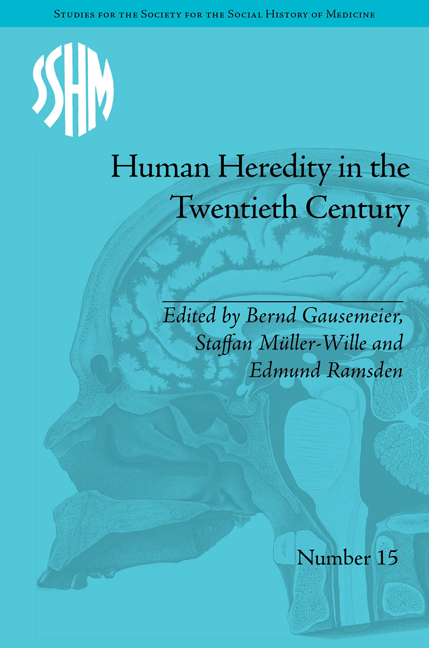Book contents
- Frontmatter
- Contents
- Acknowledgements
- List of Contributors
- List of Figures and Tables
- Introduction: Human Heredity in the Twentieth Century
- Part I Constructing Surveys of Heredity
- 1 Borderlands of Heredity: The Debate about Hereditary Susceptibility to Tuberculosis, 1882–1945
- 2 Championing a US Clinic for Human Heredity: Pre-War Concepts and Post-War Constructs
- 3 Remodelling the Boundaries of Normality: Lionel S. Penrose and Population Surveys of Mental Ability
- Part II Blood and Populations
- Part III Human Heredity in the Laboratory
- Part IV Understanding and Managing Disease
- Part V Reconstructing Discipline(s)
- Notes
- Index
2 - Championing a US Clinic for Human Heredity: Pre-War Concepts and Post-War Constructs
from Part I - Constructing Surveys of Heredity
- Frontmatter
- Contents
- Acknowledgements
- List of Contributors
- List of Figures and Tables
- Introduction: Human Heredity in the Twentieth Century
- Part I Constructing Surveys of Heredity
- 1 Borderlands of Heredity: The Debate about Hereditary Susceptibility to Tuberculosis, 1882–1945
- 2 Championing a US Clinic for Human Heredity: Pre-War Concepts and Post-War Constructs
- 3 Remodelling the Boundaries of Normality: Lionel S. Penrose and Population Surveys of Mental Ability
- Part II Blood and Populations
- Part III Human Heredity in the Laboratory
- Part IV Understanding and Managing Disease
- Part V Reconstructing Discipline(s)
- Notes
- Index
Summary
Early US eugenic attempts at institutionalizing human heredity resulted in the formation of the Eugenic Record Office (ERO) in 1910. For the next few decades, the ERO served as a repository of eugenical information, an ‘analytical index’ of the traits and diseases of American families, a training centre for field workers who gathered eugenical data, an investigatory stronghold for identifying the inheritance of specific human traits, and an advice clearinghouse regarding the ‘eugenical fitness’ of proposed marriages. Initially, ERO work was restricted to investigating institutionalized persons and select volunteer families. Over the years its aims grew towards surveying whole populations via the networking of physicians on one hand and undertaking more specific medical studies of heredity on the other. To accomplish this last aim, a Clinic for Human Heredity was proposed. However, plans for such a clinic were not realized by World War II. Only after the war, when human genetics became more embedded in medical practice, was such a clinic established. This essay discusses two approaches towards establishing medical institutions specialized in the study of human heredity: the plans promoted by the prominent eugenicist Harry H. Laughlin in the 1930s, and the genetics clinic realized by the medical geneticist Victor A. McKusick in the 1950s.
- Type
- Chapter
- Information
- Human Heredity in the Twentieth Century , pp. 27 - 38Publisher: Pickering & ChattoFirst published in: 2014



